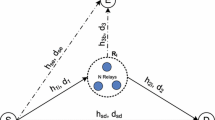Abstract
A distributed multi-antenna cooperative communication system with amplify-and-forward mode for secure communication in the presence of an eavesdropper is considered. In the communication system, there is no direct communication link between the transmitter and the intended receiver, and all nodes except relay nodes are equipped with multi-antenna. The secrecy capacity of this multiple input multiple output multiple eavesdropper system is investigated. The communication security depends on whether the noise on wiretap channel is stronger than that on main channel or not. The secrecy outage behavior of the flat Rayleigh fading channel is discussed and a relation between the strength of the channel noise and the secrecy outage probability is obtained. It is demonstrated that the secrecy outage probability is closely related to the channel noise strength and the number of the relay nodes. The thresholds for the noises received by legitimate receiver and eavesdropper are suggested, which is useful to design the secure distributed multi-antenna cooperative communication system.




Similar content being viewed by others
References
Wyner, A. D. (1975). The wire-tap channel. Bell System Technical Journal, 54(8), 1355–1387.
Leung-Yan-Cheong, S. K., & Hellman, M. E. (1978). The Gaussian wire-tap channel. IEEE Transactions on Information Theory, 24, 451–456.
Shafiee, S., & Ulukus, S. (2007). Achievable rates in Gaussian MISO channels with secrecy constraints. IEEE International Symposium on Information Theory, 1(7), 2466–2470.
Tian, M., Huang, X., Zhang, Q., & Qin, J. (2015). Robust AN-aided secure transmission scheme in MISO channels with simultaneous wireless information and power transfer. IEEE Signal Processing Letters, 22(6), 723–727.
Chen, X., & Chen, H. (2014). Physical layer security in multi-cell MISO downlinks with incomplete CSI—A unified secrecy performance analysis. IEEE Transactions on Information Theory, 62(23), 6286–6297.
Fakoorian, S. A. A., & Swindlehurst, A. L. (2011). Secrecy capacity of MISO Gaussian wiretap channel with a cooperative jammer. In IEEE 12th workshop on signal processing advance in wireless communications (pp. 416–420).
Zhu, J., Schober, R., & Bhargava, V. K. (2014). Secure transmission in multicell massive MIMO systems. IEEE Transactions on Wireless Communications, 13(9), 4766–4781.
Shen, C., Li, W., & Chang, T. (2014). Wireless information and energy transfer in multi-antenna interference channel. IEEE Transactions on Signal Processing, 62(23), 6249–6264.
Parada, P., & Blahut, R. (2005). Secrecy capacity of SIMO and slow fading channels. IEEE international symposium on information theory (pp. 2152–2155).
Xiong, Q., Gong, Y., Liang, Y., & Li, K. (2014). Achieving secrecy of MISO fading wiretap channels via jamming and precoding with imperfect channel state information. IEEE Wireless Communications Letters, 3(4), 357–360.
Gerbracht, S., Scheunert, C., & Jorwieck, A. (2012). Secrecy outage in MISO systems with partial channel information. IEEE Transactions on Information Forensics and Security, 7(2), 704–716.
Wang, H., Zheng, T., & Xia, X. (2015). Secure MISO wiretap channels with multiantenna passive eavesdropper: artificial noise vs. artificial fast fading. IEEE Transactions on Wireless Communications, 14(1), 94–106.
Zhang, X., Mckay, M. R., Zhou, X., et al. (2015). Artificial-noise-aided secure multi-antenna transmission with limited feedback. IEEE Transactions on Wireless Communications, 14(5), 2742–2753.
Chang, N., Chae, C. B., Ha, J., et al. (2012). Secrecy rate for MISO Rayleigh fading channels with relative distance of eavesdropper. IEEE Communications Letters, 16(9), 1408–1411.
Wang, B., Mu, P., & Li, Z. (2015). Secrecy rate maximization with artificial-noise-aided beamforming for MISO wiretap channels under secrecy outage constraint. IEEE Communications Letters, 19(1), 18–21.
Khisti, A., & Wornell, G. W. (2010). Secure transmission with multiple antenna I: the MISOME wiretap channel. IEEE Transactions on Information Theory, 56(7), 3088–3104.
Khisti, A., & Wornell, G. W. (2010). Secure transmission with multiple antenna II: The MIMOME wiretap channel. IEEE Transactions on Information Theory, 56(11), 5515–5532.
Fakoorian, S. A. A., & Swindlehurst, A. L. (2013). Competing for secrecy in the MISO interference channel. IEEE Transaction on Signal Processing, 61(1), 170–181.
Li, J., & Petropulu, A. P. (2011). On ergodic secrecy rate for Gaussian MISO wiretap channels. IEEE Transaction on Wireless Communications, 10(4), 1176–1187.
Li, J., & Petropulu, A. P. (2012). Explicit solution of worst-case secrecy rate for MISO wiretap channels with spherical uncertainty. IEEE Transaction on Signal Processing, 60(7), 3892–3895.
Son, P. N., & Kong, H. Y. (2014). Exact outage probability of two-way decode-and-forward scheme with opportunistic relay selection under physical layer security. IEEE Wireless Personal Communications, 51(1), 6249–6264.
Pinto, P. C., Barros, J., & Win, M. Z. (2009). Wireless physical-layer security: the case of colluding eavesdroppers. In IEEE international symposium on information theory (pp. 2442–2446).
Yang, N., Yeoh, P. L., & Elkashlan, M. (2013). MIMO wiretap channels: Secure transmission using transmit antenna selection and receive generalized selection combining. IEEE Communication Letters, 17(9), 1754–1757.
Zhou, N. R., Chen, X., Li, C. S., & Xue, Z. (2014). Secrecy rate of two-hop AF relaying networks with an untrusted relay. Wireless Personal Communications, 75(1), 119–129.
Islam, M. R. (2010). Secret data communication in a degraded practical multiple input multiple output multiple eavesdropper channel. In Proceeding of 13th international conference on computer and information technology (pp. 594–599).
King, C. (2014). Fundamentals of wireless communications. In IEEE-IAS/PCA cement industry technical conference (pp. 470–474).
Acknowledgments
This work is supported by the National Natural Science Foundation of China (Grant No. 61371115), the Natural Science Foundation of Jiangxi Province, China (Grant No. 20132BAB201019), the Foundation for Young Scientists of Jiangxi Province (Jinggang Star) (Grant No. 20122BCB23002), the Research Foundation of the Education Department of Jiangxi Province (Grant No. GJJ14133) and the Opening Project of Shanghai Key Laboratory of Integrate Administration Technologies for Information Security (Grant No. AGK2014004).
Author information
Authors and Affiliations
Corresponding author
Rights and permissions
About this article
Cite this article
Zhou, N.R., Liang, X.R., Kang, Z.J. et al. Secrecy Outage Probability of a Distributed Multi-Antenna Cooperative Communication System. Wireless Pers Commun 90, 1635–1645 (2016). https://doi.org/10.1007/s11277-016-3415-5
Published:
Issue Date:
DOI: https://doi.org/10.1007/s11277-016-3415-5




